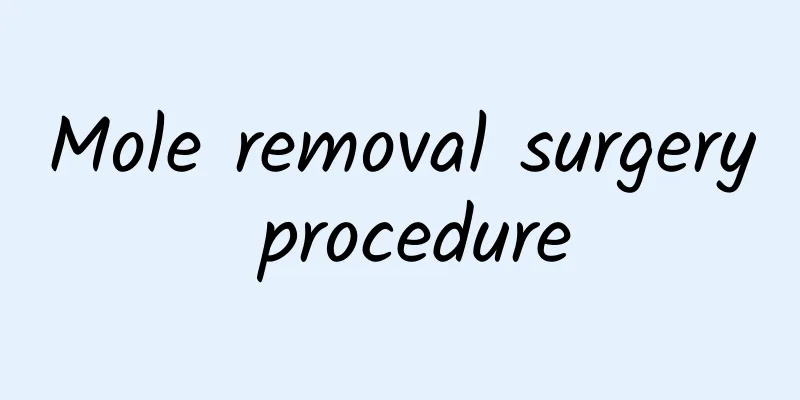Mole removal surgery procedure

|
What are the disadvantages of mole removal surgery? Everyone wants to have a bright and beautiful appearance, but when faced with the problem of mole removal, everyone wants to choose mole removal surgery, or ignore or pay attention to them and let them grow on their own. However, the growth of some moles has a great impact on our lives. So, the following will focus on introducing mole removal surgery to everyone. 1. Name of surgery Mole removal surgery on face 2. Aliases Facial mole removal surgery 3. Classification Department of Stomatology/Oral and Maxillofacial Tumor Surgery/Oral and Maxillofacial Benign Tumor Surgery IV. Overview Pigmented nevus is a common benign lesion on the skin, and about 40% of them occur on the face. Generally no treatment is required, but frequent irritation should be avoided. 5. Indications Pigmented nevi in easily irritated areas and on the lips, nose, etc. should be considered for surgical removal. If you find that a pigmented nevus grows rapidly, its pigment darkens, itches, ulcerates, bleeds, and melanin spots appear on the skin around the nevus, you should consider the possibility of malignancy and promptly perform surgical removal. Once malignant transformation occurs, timely and extensive resection is required. 6. Preoperative Preparation Prepare skin as usual. For cases suspected of malignancy, frozen section preparation should be done before surgery, and a surgical plan should be made to repair the wound after extensive resection of the lesion. 7. Anesthesia and Body Position Local infiltration anesthesia is generally used. Children can choose basic anesthesia plus local anesthesia. The surgical position can be supine or sitting. 8. Surgical steps 1. Incision The incision design depends on the size of the lesion. For smaller lesions, a fusiform incision can be made in the normal skin 1 to 2 mm outside the edge of the mole in the direction of the skin texture. If the pigmented nevus is larger in area, it can be removed by staged excision. That is, in the first operation, only fusiform excision is performed within the area of the pigmented nevus, and 1/2 to 1/3 of the lesion is removed, and then sutured. A second resection and suturing will be performed 3 to 6 months later. Generally, complete resection can be achieved after 2 to 3 resection operations. However, this method is not applicable to junctional nevi (except for juvenile junctional nevi). If the pigmented nevus is extensive, it can be completely removed at one time, and a full-thickness skin graft or skin flap can be transplanted on the wound for repair. It should be pointed out that junctional nevus can undergo malignant transformation. Therefore, an incision should be made on the normal skin more than 3 mm beyond the edge of the nevus, and all of the skin should be removed in one go. 2. Resection of diseased tissue According to the incision design, the skin layer is cut directly to the subcutaneous tissue layer, and then sharp separation is performed in the subcutaneous tissue layer to remove the diseased tissue. 3. Wound treatment After complete hemostasis, the subcutaneous tissue layer on both sides of the wound edge was separated secretly, and then the subcutaneous tissue and skin were sutured separately. If the wound is large and cannot be sutured directly, free skin grafting or adjacent skin flap transfer and repair can be used. There are also those who use skin expansion surgery, which is to expand the skin tissue adjacent to the skin defect area to create a new flap for transfer and repair of the skin defect wound. When this approach is used, the first stage of surgery is the placement of a skin expander. Two weeks after the operation, water will be injected into the skin expander, and the skin tissue will gradually expand. The expansion period is generally 2 months. The second stage of surgery can be performed 2 weeks after the last water injection. The second stage of surgery is flap transfer and reconstruction. At this time, the facial pigmented nevus is removed and the newly formed skin flap is immediately transferred to cover the skin defect wound after the nevus removal. IX. Points to note during surgery During facial mole removal surgery, in addition to paying attention to completely removing the diseased tissue, attention should also be paid to how to close the wound, especially the wound closure near the eyes, nose, and corners of the mouth, so as not to affect the function of facial organs and increase facial deformities. After the removal of the eyelid split nevus, tarsal plate and skin repair surgery should be performed immediately. 10. Postoperative Treatment After facial nevus excision wound repair with free skin grafting or flap transfer, antibiotics should be used to prevent postoperative infection. The sutures were removed 9 to 10 days after surgery. However, in cases of direct suture, the stitches can be removed 7 days after surgery. 11. Complications The main complications were postoperative infection, free skin graft necrosis and partial flap necrosis. |
>>: How to remove small black moles
Recommend
Traditional Chinese Medicine Spleen and Stomach Health Care
From the perspective of traditional Chinese medic...
Respiratory diseases
Respiratory diseases are also very common, mainly...
How to regulate weak spleen and stomach? These 4 points must be achieved!
Many people suffer from weak spleen and stomach i...
The advantages and disadvantages of cast iron pans
The advantages of cast iron pans are that they he...
What's wrong with my buttocks and eyes?
This is a kind of anal pain, and there are many r...
How to treat insufficient vitality
Insufficient vitality often leads to poor immunit...
What is pneumoconiosis
With the continuous improvement of modernization,...
What to eat when amniotic fluid is too much in late pregnancy
In the late pregnancy, if there is too much amnio...
What to do if your leg is swollen due to a fracture
Usually, due to unexpected circumstances, if a le...
What should babies pay attention to when learning to walk?
When babies grow to a certain stage, they will le...
Dosage of Asarum
There is a saying in traditional Chinese medicine...
Side effects of Baishouwu
The side effects of Baishouwu are unfamiliar to m...
What to do if fat particles grow under the eyelashes
It is quite common to have fat particles under th...
Effects of Shuxuetong Injection
Shuxuetong Injection is a common medicine used fo...
Symptoms of bedsores in the elderly
Many people will suffer from bedsores when they g...









